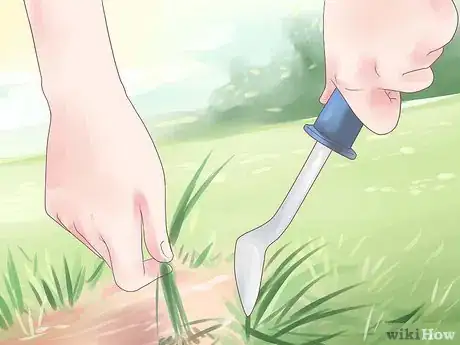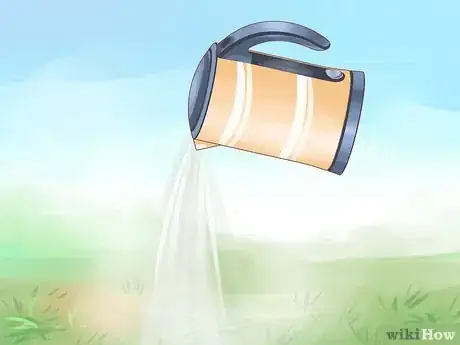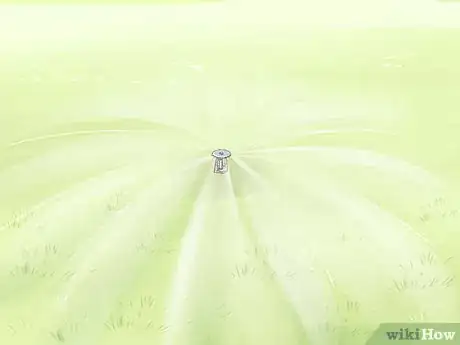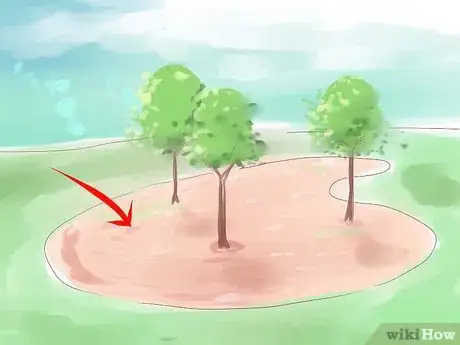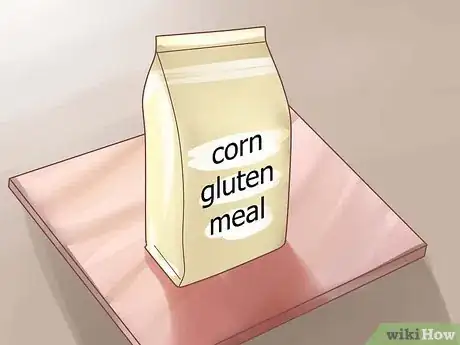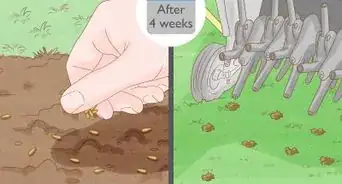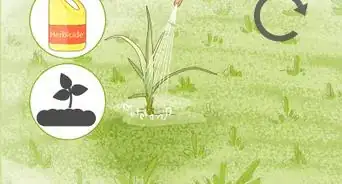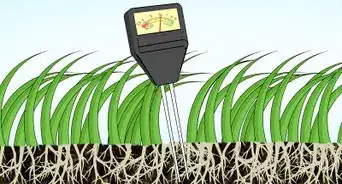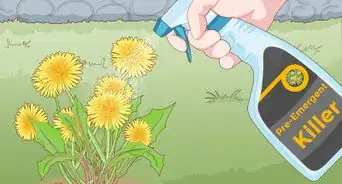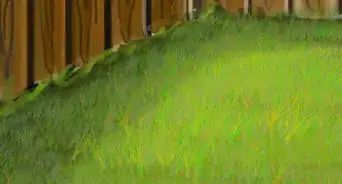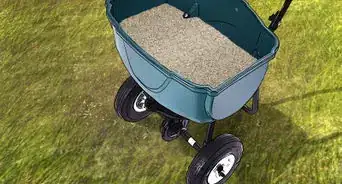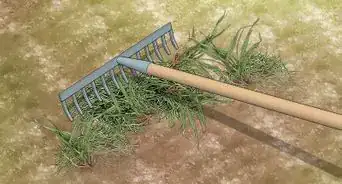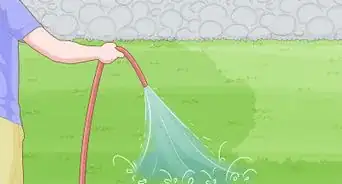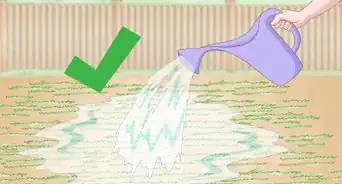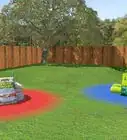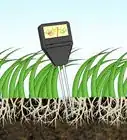This article was co-authored by Grant Wallace. Grant Wallace is a Landscaper and Owner of Grantlanta Lawn in Atlanta, Georgia. With over seven years of experience, he specializes in lawn maintenance and landscape installation. In 2012, he earned his BA from the University of West Georgia. Grant has been profiled in Shoutout Atlanta, Canvas Rebel, and Voyage ATL.
wikiHow marks an article as reader-approved once it receives enough positive feedback. In this case, several readers have written to tell us that this article was helpful to them, earning it our reader-approved status.
This article has been viewed 108,052 times.
Crabgrass is an annual that is spread by seed. It's a fairly common weed and it looks unsightly if it takes hold over much of a lawn. While it's unlikely you'll ever get rid of it completely, if you maintain a healthy lawn and attack it patiently, you will get the upper hand over most of it.
Steps
-
1Hand pick the crabgrass as it grows. Use a hoe or picking tool to assist. Aim to do this prior to the seeds appearing; once the seeds appear, it will spread rapidly. It is a good idea to get into the habit of walking around after the weekly watering to check for crabgrass and pull it out while the soil is still moist. Dispose of the weed in the bin or burn it rather than composting. This will avoid spread of any seeds.[1]
- Just do your best to handle it periodically, so it doesn't get out of hand. If you let it go for months upon months, you will feel overwhelmed when it comes time to do maintenance.
-
2Pour boiling water directly on the crabgrass plant. This requires a deft hand, however, because if you water any of the grass you want to keep, it will also die.[2]Advertisement
-
3Keep the lawn well watered. Water deeply and not too frequently. A lawn without adequate watering is weaker and the drier environment lets crabgrass take over. Water once a week and allow the lawn to soak up 2.5 cm / 1 inch of water. The best time to water is early morning.[3]
- If you have sprinklers, make sure they are watering your lawn evenly. Try setting up cups all around your lawn before running the sprinklers to check this.
-
4Keep the lawn mowed above 6.5 - 7.5 cm / 2.5 - 3 inches. Higher lawns let in less sunlight, removing the optimal growing conditions for an annual grass such as crabgrass. Never cut more than a third of a grass plant at a time.[4]
-
5Ensure that the lawn is well fertilized. Fertilize regularly. The best way is to use a slow-release, granular fertilizer. Alternately, consider using a top dressing of organic material such as compost, kelp, bone, or blood meal.
-
6Mulch the lawn after removal of crabgrass. This is especially important to fill any gaps left from pulling out the crabgrass. Leave grass clippings on the lawn post mowing. This returns nutrients to the soil, saves you picking them up and you can reduce the use of fertilizer by 30 percent. Mulching helps ensure that crabgrass roots cannot take hold again.
-
7Consider using corn gluten meal. This will interfere with the development of the root system of crabgrass. It should be sown during the early months of spring and the lawn should be allowed to dry out between weekly waterings for this to work successfully (crabgrass is shallow rooted and needs water to keep its hold).[5]
Community Q&A
-
QuestionI used crabgrass killer last fall, now all my crabgrass is brown and the grass is green. Still, the crabgrass seems attached. What should I do?
 Community AnswerYank it out or kick it free with your foot. You got the roots, so you just need to remove it so the real grass can spread over the spot.
Community AnswerYank it out or kick it free with your foot. You got the roots, so you just need to remove it so the real grass can spread over the spot. -
QuestionI am hand pulling all crab grass in preparation for Bermuda or Zoysia grass. I am digging at least 6-8 inches down, making sure that there are no crabgrass roots. Should I plastic cover the area?
 Community AnswerSure, plastic will assist in killing the main plant, but it won't do anything for seeds that disbursed. Bermuda will be as infiltrated as any lawn. But Zoysia grass will choke-out most anything, including new crabgrass.
Community AnswerSure, plastic will assist in killing the main plant, but it won't do anything for seeds that disbursed. Bermuda will be as infiltrated as any lawn. But Zoysia grass will choke-out most anything, including new crabgrass. -
QuestionHow can I get rid of large amounts of crabgrass without killing the good grass?
 Pat CallahanCommunity AnswerFor a chemical-free method, use a pair of long needle nose pliers. Get under the central whorl of the crabgrass and yank out most of the roots. Start as early in the season as you can, and be sure to get the root and the central whorl or it will just grow back. A garden kneeler will help. Pick a high priority area and establish a zero tolerance zone there, removing every crabgrass plant in the zone. Be vigilant; don't allow even one crabgrass plant to thrive and throw seeds and tillers in that area. Expand the area year to year and you'll be surprised how effective this is. Remove as many plants with a central whorl from other areas as you have time for.
Pat CallahanCommunity AnswerFor a chemical-free method, use a pair of long needle nose pliers. Get under the central whorl of the crabgrass and yank out most of the roots. Start as early in the season as you can, and be sure to get the root and the central whorl or it will just grow back. A garden kneeler will help. Pick a high priority area and establish a zero tolerance zone there, removing every crabgrass plant in the zone. Be vigilant; don't allow even one crabgrass plant to thrive and throw seeds and tillers in that area. Expand the area year to year and you'll be surprised how effective this is. Remove as many plants with a central whorl from other areas as you have time for.
Things You'll Need
- Hoe or picking tool
- Gardening gloves
- Hot water (optional)
- Mulch
- Fertilizer
- Lawnmower
- Watering system
- Corn gluten meal
References
- ↑ http://www.allaboutlawns.com/lawn-weeds-pests/10-steps-to-become-crabgrass-free.php
- ↑ http://www.garden-counselor-lawn-care.com/kill-crabgrass.html
- ↑ https://www.popularmechanics.com/home/lawn-garden/how-to/g849/the-smarter-way-to-water-your-lawn/
- ↑ https://www.weedmancanada.com/blog/top-6-ways-maximize-your-lawn-care-investment
- ↑ https://extension.umd.edu/hgic/topics/corn-gluten-crabgrass-control
